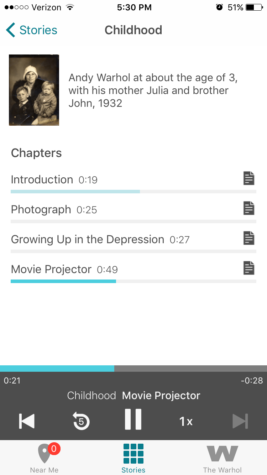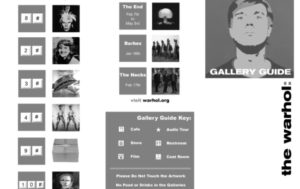
Screen shot of a play screen from Out Loud, The Warhol’s audio guide.
This is the fourth post in a series about the development process of The Warhol’s new audio guide.
If you want to know all about Andy Warhol, just look at the surface: of my paintings and films and me, and there I am. There’s nothing behind it. — Andy Warhol
While Andy Warhol might have quipped that there was no “mystery” behind his work, we in The Warhol’s education department continually strive to demystify one of the most complex artists of the 20th century. As a member of The Warhol’s education team for over 15 years, I’ve had the opportunity to be the content lead on three different iterations of the museum’s audio guide. By reinterpreting our collection and preserving our museum’s history through the broader use of digital technologies, we’ve had the opportunity to enhance the visitor experience each and every time.
2008: Guide by Cell, The Warhol’s First Audio Guide
In 2007 we began looking into integrating simple and familiar mobile technologies into the visitor experience. In 2008 I attended the American Association of Museums (AAM) annual conference in Denver, Colorado, where I sat in on a Small Museums & Technology Panel that posed the question “Can and Should Small Museums Be Technological Leaders?.” My immediate response was YES…YES we should, and cost shouldn’t be a prohibitive factor. Fortuitously, I met a representative from a company there called Guide by Cell (GBC) who, since 2004, has grown to become the leading provider of affordable mobile engagement solutions. Our partnership was born, and the education department set out to create its first series of podcasts based on the museum’s permanent collection.
During this time, a traditional museum podcast followed a recipe-like production beginning with a content script of 150–300 words, which resulted in audio clips 2–3 minutes in length. We recorded the audio using a ZOOM H4N portable digital recorder and edited using Audacity, which is free, open source software. A nice feature of GBC was that we could also record phone interviews with artists, scholars, and curators, which in turn allowed us to create audio content for our traveling exhibitions. Visitors accessed the audio guide by dialing the tour number and then entering the prompt number next to the artwork. A later version of GBC allowed users to access the audio content using QR codes. While this “new” mobile technology offered many things, there were many things that it did not…including accessibility for our visitors with low/no vision or hearing loss.

2014: The Warhol’s First Attempt at Audio Visual Descriptions
Fast forward to the summer of 2014 and our blockbuster exhibition Halston and Warhol: Silver and Suede. Again we embarked on a new audio guide to enhance the visitor experience, only this time we designed it with our low/no vision as well as the deaf and hard of hearing community in mind. Our education team participated in numerous trainings and workshops centered around improving our interpretation and accessibility initiatives. We came away with the knowledge of producing audio visual descriptions and a toolbox of best practices for engaging audiences with low/no vision. We set out recording 12 audio stops with interviews from curators, scholars, collectors, friends, and family of both Warhol and Halston. In addition, we created 12 audio visual descriptions of key Warhol artworks and Halston designs. We also made transcripts available so that visitors who are deaf or hard of hearing could also interact with the exhibition.
The content was delivered using iPods and low-energy Bluetooth beacons, placed on or near the artwork, to push content out to visitors based on where they were located in the gallery. This technology allowed us to move away from QR codes and visitors having to read numbers on a wall label and type them into the phone. Instead, the iOS application notified you when there was relevant audio nearby. While excited by new technologies and motivated with best practices in accessibility, we quickly learned from our user testing that our best practices…weren’t the best. Users found the prescribed, industry standard audio visual description template that we used to create content long and boring. And due to the close proximity of artworks and temporary exhibition walls, the Bluetooth beacons caused interference with one another resulting in premature audio starts and stops. However, our deaf and hard of hearing audiences did find the transcripts of the audio content easily accessible and enhancing to their overall visitor experience. Onward and upward!
2016: The Warhol’s Newest Inclusive Audio Guide: Out Loud
This year we set out to once again to reimagine a new audio experience for our museum visitors. We began with a focus group including members of the community with low/no vision, some of whom were familiar with our 2014 audio guide. Our biggest take away in terms of creating new audio content was that users wanted a “path with choice.” This meant creating and delivering content in a way that provided a curated visitor experience but allowed the user to order the content based on their interests and needs. We began by getting rid of the old audio visual description template and created content around themes suggested by the users, such as brief introductions to the artwork, short visual descriptions, historical and cultural context, points of view and artist interviews, as well as supporting information like music clips, podcasts, or archival audio. In terms of content delivery, instead of providing 2–3 minute clips, the new audio content branches out into smaller, modular stops mostly under 1 minute in length.
Another key finding this time around was that users from this community often visited the museum as a social experience and desired an audio guide that didn’t impede that experience, but enhance it. Therefore, this iteration of the audio guide was built with a universal audience in mind. Visitors with low/no vision can access the audio content using VoiceOver technology, and our deaf and hard of hearing audience can simply use one of our neck loops that broadcasts to their hearing aids. Audio splitters are also available for visitors who want to share in the same audio experience at the same time.
We at The Warhol believe that the process of viewing an artwork is both creative and active and an important aspect of the creative process. Therefore, through meeting people where they are and engaging them in the interpretation of the collection, we are able to reach our vision of becoming an active community of learners by encouraging dialogue and expression about art and contemporary life.
Accessibility initiatives at The Warhol are generously supported by Allegheny Regional Asset District, The Edith L. Trees Charitable Trust, and the FISA Foundation in honor of Dr. Mary Margaret Kimmel.
Out Loud, The Warhol’s new audio guide, will be available at the museum fall 2016.